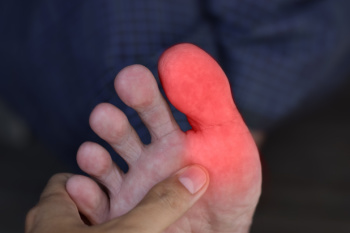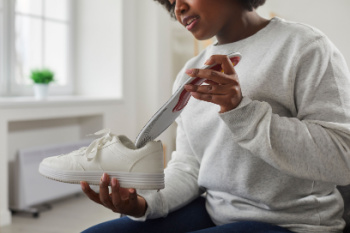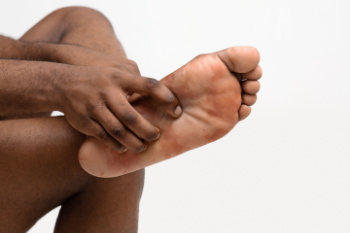Items filtered by date: August 2024
Exercising Flat Feet for Better Foot Health

Flat feet, or fallen arches, occur when the arches of the feet collapse, leading to potential discomfort and alignment issues. To alleviate symptoms and strengthen the feet, several exercises can be beneficial. Heel stretches involve gently pulling the heel and calf muscles to increase flexibility and reduce tension. Rolling a tennis ball under the foot helps massage the arch, improve circulation, and relieve pain. Arch lifts, performed by lifting the arch while keeping the toes and heel on the ground, strengthen the muscles supporting the arch. Calf raises, where you rise onto the toes and slowly lower back down, enhance calf strength and support the foot’s structure. Flat feet may cause pain and discomfort. If this applies to you, it is suggested that you are under the care of a podiatrist who can help you find the relief you are seeking.
Flatfoot is a condition many people suffer from. If you have flat feet, contact Daniel Mendoza, DPM from Nashville Podiatry. Our doctor will treat your foot and ankle needs.
What Are Flat Feet?
Flatfoot is a condition in which the arch of the foot is depressed and the sole of the foot is almost completely in contact with the ground. About 20-30% of the population generally has flat feet because their arches never formed during growth.
Conditions & Problems:
Having flat feet makes it difficult to run or walk because of the stress placed on the ankles.
Alignment – The general alignment of your legs can be disrupted, because the ankles move inward which can cause major discomfort.
Knees – If you have complications with your knees, flat feet can be a contributor to arthritis in that area.
Symptoms
- Pain around the heel or arch area
- Trouble standing on the tip toe
- Swelling around the inside of the ankle
- Flat look to one or both feet
- Having your shoes feel uneven when worn
Treatment
If you are experiencing pain and stress on the foot you may weaken the posterior tibial tendon, which runs around the inside of the ankle.
If you have any questions please feel free to contact our office located in Hendersonville, TN . We offer the newest diagnostic and treatment technologies for all your foot and ankle needs.
Peripheral Artery Disease and the Feet

Peripheral artery disease, or PAD, can significantly affect the feet, often causing pain, even during normal activities like walking. This discomfort, medically known as claudication, occurs because of reduced blood flow due to plaque buildup in the arteries. Symptoms of PAD in the feet include cramps, numbness, skin discoloration, temperature changes, and the development of ulcers. These symptoms are concerning because they indicate insufficient blood circulation, which, if untreated, could lead to serious conditions like limb ischemia. In severe cases, this can result in tissue death or even amputation. It is vital for individuals with peripheral artery disease to engage in regular, supervised exercise to improve circulation. A podiatrist can help to manage the effects of PAD by providing specialized foot care, monitoring symptoms, and advising on exercise programs tailored to enhance blood flow. They can also guide patients in footwear choices and care for ulcers to prevent infections. If you have foot problems related to peripheral artery disease, it is suggested that you schedule an appointment with a podiatrist for treatment.
Peripheral artery disease can pose a serious risk to your health. It can increase the risk of stroke and heart attack. If you have symptoms of peripheral artery disease, consult with Daniel Mendoza, DPM from Nashville Podiatry. Our doctor will assess your condition and provide you with quality foot and ankle treatment.
Peripheral artery disease (PAD) is when arteries are constricted due to plaque (fatty deposits) build-up. This results in less blood flow to the legs and other extremities. The main cause of PAD is atherosclerosis, in which plaque builds up in the arteries.
Symptoms
Symptoms of PAD include:
- Claudication (leg pain from walking)
- Numbness in legs
- Decrease in growth of leg hair and toenails
- Paleness of the skin
- Erectile dysfunction
- Sores and wounds on legs and feet that won’t heal
- Coldness in one leg
It is important to note that a majority of individuals never show any symptoms of PAD.
Diagnosis
While PAD occurs in the legs and arteries, Podiatrists can diagnose PAD. Podiatrists utilize a test called an ankle-brachial index (ABI). An ABI test compares blood pressure in your arm to you ankle to see if any abnormality occurs. Ultrasound and imaging devices may also be used.
Treatment
Fortunately, lifestyle changes such as maintaining a healthy diet, exercising, managing cholesterol and blood sugar levels, and quitting smoking, can all treat PAD. Medications that prevent clots from occurring can be prescribed. Finally, in some cases, surgery may be recommended.
If you have any questions, please feel free to contact our office located in Hendersonville, TN . We offer the newest diagnostic and treatment technologies for all your foot care needs.
Custom Orthotics For Seniors

Age gracefully and move freely with Custom Orthotics. For seniors seeking to maintain their independence, Custom Orthotics offer the stability and comfort essential for daily activities. Custom-tailored to your feet, they provide support, reduce pain, and enhance mobility, ensuring you're always on sure footing. Don't let age-related foot concerns hold you back. With Custom Orthotics, embrace every golden moment with confidence. Call today to schedule an appointment.
Common Causes of Big Toe Joint Pain

Pain in the big toe joint can stem from various conditions, with arthritis, bunions, and extensor tendonitis being common culprits. Arthritis in the big toe joint often leads to inflammation and stiffness, resulting in discomfort and limited movement. A bunion, characterized by a bony protrusion at the base of the big toe, can cause significant pain due to misalignment and increased pressure on the joint. Extensor tendonitis occurs when the tendons responsible for lifting the toe become inflamed, leading to pain and difficulty in movement. Each condition can contribute to discomfort and mobility issues, making early diagnosis and appropriate treatment essential for effective management and relief. If you have pain in your big toe, it is suggested that you consult a podiatrist who can accurately diagnose the cause and offer you appropriate treatment solutions.
Toe pain can disrupt your daily activities. If you have any concerns, contact Daniel Mendoza, DPM of Nashville Podiatry. Our doctor can provide the care you need to keep you pain-free and on your feet.
What Causes Toe Pain?
Most severe toe pain is caused due to a sports injury, trauma from dropping something heavy on the toe, or bumping into something rigid. Other problems can develop over time for various reasons.
Toe pain can be caused by one or more ailments. The most common include:
- Trauma
- Sports injury
- Wearing shoes that are too tight
- Arthritis
- Gout
- Corns and calluses
- Hammertoe
- Bunions
- Blisters
- Ingrown toenails
- Sprains
- Fractures (broken bones)
- Dislocations
When to See a Podiatrist
- Severe pain
- Persistent pain that lasts more than a week
- Signs of infection
- Continued swelling
- Pain that prevents walking
Diagnosis
In many cases the cause of toe pain is obvious, but in others, a podiatrist may want to use more advanced methods to determine the problem. These can range from simple visual inspections and sensation tests to X-rays and MRI scans. Prior medical history, family medical history, and any recent physical traumatic events will all be taken into consideration for a proper diagnosis.
Treatment
Treatments for toe pain and injuries vary and may include shoe inserts, padding, taping, medicines, injections, and in some cases, surgery. If you believe that you have broken a toe, please see a podiatrist as soon as possible.
If you have any questions please feel free to contact our office located in Hendersonville, TN . We offer the newest diagnostic tools and technology to treat your foot and ankle needs.
Heel Pain in the Morning?
Foot Orthoses and Balance in Healthy Older People

Foot orthoses and proper footwear are vital in maintaining balance and mobility for healthy older individuals. As we age, changes in foot structure and reduced muscle strength can affect stability. Orthoses help by providing support and correcting foot alignment, preventing falls, and enhancing confidence in walking. Choosing appropriate shoes with sturdy soles and good arch support further aids in stability. These shoes should fit well to prevent discomfort and allow for proper foot function. Orthoses and supportive footwear work together to distribute weight evenly, reduce pressure points, and improve overall posture. This combination not only enhances balance but also reduces the risk of foot-related issues like plantar fasciitis or bunions. If you are considering wearing orthotics, it is suggested that you consult a podiatrist who can determine if this is the right choice for you.
If you are experiencing discomfort in your feet and would like to try custom orthotics, contact Daniel Mendoza, DPM from Nashville Podiatry. Our doctor can provide the care you need to keep you pain-free and on your feet.
What Are Custom Orthotics?
Custom orthotics are inserts you can place into your shoes to help with a variety of foot problems such as flat feet or foot pain. Orthotics provide relief and comfort for minor foot and heel pain.
Over-the-Counter Inserts
Shoe inserts come in a wide variety and are used to treat foot pain, heel pain, and minor problems. For example, arch supports can be inserted into your shoes to help correct overarched or flat feet, while gel insoles are often used because they provide comfort and relief from foot and heel pain by alleviating pressure.
Prescription Orthotics
If over-the-counter inserts don’t work for you or if you have a more severe foot concern, it is possible to have your podiatrist prescribe custom orthotics. These high-quality, custom inserts are designed to treat problems such as abnormal motion, plantar fasciitis, and severe forms of heel pain. They can even be used to help patients suffering from diabetes by treating foot ulcers and painful calluses and are usually molded to your feet individually, which allows them to provide full support and comfort.
If you're experiencing minor to severe foot or heel pain, it’s recommended to speak with your podiatrist about the possibility of using custom orthotics or shoe inserts. A podiatrist can determine which type of custom orthotic or shoe insert is right for you and help you take the first steps toward being pain-free.
If you have any questions please contact our office located in Hendersonville, TN . We offer the newest diagnostic and treatment technologies for all your foot and ankle needs.
Plantar Fasciitis Relief
 Plantar fasciitis is a common cause of heel pain, resulting from inflammation of the plantar fascia, which is a thick band of tissue connecting the heel bone to the toes. This condition often develops due to repetitive strain or overuse, common in runners, people who stand for long periods, or those with high arches or flat feet. Symptoms can include sharp, stabbing pain in the heel, especially noticeable with the first steps in the morning or after prolonged sitting. The pain typically decreases with movement but may return after extended activity. Contributing factors include wearing unsupportive footwear, obesity, and having tight calf muscles. Treatment focuses on relieving inflammation and pain. Common approaches include rest, stretching exercises, and using orthotic inserts to support the arch. Nonsteroidal anti-inflammatory drugs can also help to reduce pain and swelling. In persistent cases, corticosteroid injections or surgery may be considered. If you have heel pain, it is suggested that you visit a podiatrist for a proper diagnosis and tailored treatment plan.
Plantar fasciitis is a common cause of heel pain, resulting from inflammation of the plantar fascia, which is a thick band of tissue connecting the heel bone to the toes. This condition often develops due to repetitive strain or overuse, common in runners, people who stand for long periods, or those with high arches or flat feet. Symptoms can include sharp, stabbing pain in the heel, especially noticeable with the first steps in the morning or after prolonged sitting. The pain typically decreases with movement but may return after extended activity. Contributing factors include wearing unsupportive footwear, obesity, and having tight calf muscles. Treatment focuses on relieving inflammation and pain. Common approaches include rest, stretching exercises, and using orthotic inserts to support the arch. Nonsteroidal anti-inflammatory drugs can also help to reduce pain and swelling. In persistent cases, corticosteroid injections or surgery may be considered. If you have heel pain, it is suggested that you visit a podiatrist for a proper diagnosis and tailored treatment plan.
Plantar fasciitis can be very painful and inconvenient. If you are experiencing heel pain or symptoms of plantar fasciitis, contact Daniel Mendoza, DPM from Nashville Podiatry. Our doctor can provide the care you need to keep you pain-free and on your feet.
What Is Plantar Fasciitis?
Plantar fasciitis is the inflammation of the thick band of tissue that runs along the bottom of your foot, known as the plantar fascia, and causes mild to severe heel pain.
What Causes Plantar Fasciitis?
- Excessive running
- Non-supportive shoes
- Overpronation
- Repeated stretching and tearing of the plantar fascia
How Can It Be Treated?
- Conservative measures – anti-inflammatories, ice packs, stretching exercises, physical therapy, orthotic devices
- Shockwave therapy – sound waves are sent to the affected area to facilitate healing and are usually used for chronic cases of plantar fasciitis
- Surgery – usually only used as a last resort when all else fails. The plantar fascia can be surgically detached from the heel
While very treatable, plantar fasciitis is definitely not something that should be ignored. Especially in severe cases, speaking to your doctor right away is highly recommended to avoid complications and severe heel pain. Your podiatrist can work with you to provide the appropriate treatment options tailored to your condition.
If you have any questions please feel free to contact our office located in Hendersonville, TN . We offer the newest diagnostic and treatment technologies for all your foot and ankle needs.

